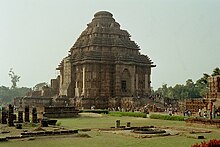Jagamohana


A Jagamohana (Sanskrit: जगमोहन, romanized: jagamōhana),[1][2] also rendered Jagamohana (Odia: ଜଗମୋହନ) is an assembly hall[3] in Hindu temple architecture, especially found in the region of Odisha.[4][5]
Overview[edit]
A jagamohana is located in front of the main shrine of the temple, called the garbhagriha.[6] It is typical of the Nagara architecture temples of northern India. In the south of India, the halls are named mandapas, which are often large halls with columns.
As in a garbhagriha, it is most often built on a plan based on structures of squares and circles. However, for the temples of goddesses, the jagamohana is built on a plan based on structures of rectangles and triangles. Such as for example the plan of the temple of Varahi Deula at Chaurasi near Puri in Odisha.[4]
Generally, the garbhagriha is a windowless and sparsely lit chamber, intentionally created thus to focus the devotee's mind on the tangible form of the divine within it. On the contrary, the jagamohana is highly decorated with sculptures of deities, mythological scenes, or ornaments.
The most famous jagamohana is that of the Konark Sun Temple. Due to the collapse of the main temple tower (shikhara), the jagamohana now appears to be the main building of the temple.
References[edit]
- ^ Orissa Society of Americas 25th Annual Convention Souvenir: For Annual Convention Held in 1994 at Pamona, New Jersey. Odisha Society of the Americas. p. 31.
- ^ Menon, Usha (2013-03-01). Women, Wellbeing, and the Ethics of Domesticity in an Odia Hindu Temple Town. Springer Science & Business Media. p. 32. ISBN 978-81-322-0885-3.
- ^ Kulke, Hermann; Sahu, Bhairabi Prasad (2022-01-13). The Routledge Handbook of the State in Premodern India. Taylor & Francis. p. 487. ISBN 978-1-000-48514-1.
- ^ a b Volwahsen, Andreas (1968). Inde bouddhique, hindoue, jaïn. Architecture universelle (in French). Fribourg, Switzerland: Office du Livre, Fribourg. pp. 50–57.
- ^ "Architecture of the Indian Subcontinent - Glossary". Retrieved 2012-08-15.
- ^ Boner, Alice (1990). Principles of Composition in Hindu Sculpture: Cave Temple Period. Motilal Banarsidass Publ. p. 253. ISBN 978-81-208-0705-1.
